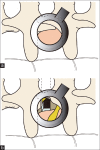[Minimally invasive extraforaminal lumbar interbody fusion]
- PMID: 29430325
- PMCID: PMC5799939
- DOI: 10.4103/sni.sni_280_17
[Minimally invasive extraforaminal lumbar interbody fusion]
Abstract
Objectives: The objective of the present study was to determine the indications, surgical technique, results, and complications of minimally invasive extraforaminal lumbar interbody fusion (ELIF).
Introduction: ELIF is characterized as removal of the superior articular process (SAP) to access the intra-canalicular root and disc through Kambin's triangle.
Methods: A retrospective study was conducted of 40 patients operated upon between 2013 and 2015. Patients with low back pain or root pain due to degenerative disc disease, spondylolisthesis grade 1 and 2, recurrent disc herniation, and recess-foraminal stenosis were included. A visual analogue scale (VAS), the Oswestry index, the Weiner scale and the modified MacNab criteria were used to assess pain, clinical and functional results and patient satisfaction one year after surgery. Complications were documented and rated according to their severity, in four degrees.
Results: We operated on 25 women and 15 men of average age 57 years. Of the forty, 47.5% were treated for spondylolisthesis, 25% by recess foraminal stenosis. In total, 54 interbody cages and 188 percutaneous pedicle screws were placed; and the mean duration of surgery was 245 (±25.4) minutes. The mean hospitalization time was 3.5 (±0.49) days. We observed nine Grade 1 and one Grade 2 complication. The mean preoperative ODI score was 51.9 ± 4.96, which improved to 12.2 ± 3.19 at one year (P < 0.0001). The mean VAS low back pain rating improved from 8.81 ± 0.62 to 2.12 ± 0.89 (P < 0.0001). By one year post-operatively, 77.5% of the patients had fusion (Bridwell grade 1 or 2).
Conclusions: ELIF is a safe and effective surgical approach. Satisfactory clinical outcomes, comparable to traditional techniques, can be achieved with facet resection limited to the superior articular process.
Objetivo:: El objetivo del presente trabajo es mostrar la indicación, técnica quirúrgica, resultados y complicaciones de la vía de abordaje extraforaminal para fusión intersomática (ELIF) mínimamente invasiva.
Introducción:: El ELIF se caracteriza por la remoción del proceso articular superior (PAS) y el acceso a la raíz intracanalicular y disco a través del triángulo de seguridad de Kambin.
Material y Métodos:: Estudio retrospectivo de 40 pacientes operados consecutivamente entre el 2013 y 2015. Se incluyeron pacientes con lumbalgia o dolor radicular por enfermedad degenerativa discal, espondilolistesis grado 1 y 2, hernia discal recurrente y estenosis receso-foraminales. Se utilizó la escala visual analógica, el índice de Oswestry, la escala de Weiner y los criterios de MacNab modificados para evaluar el dolor, resultados clínico-funcionales y satisfacción del paciente al año de la cirugía. Las complicaciones fueron documentadas de acuerdo a su gravedad en 4 grados.
Resultados:: 25 mujeres/15 hombres con una edad promedio de 57 años. El 47.5% fueron tratados por espondilolistesis, el 25% por estenosis receso-foraminal. Se colocaron 54 cajas intersomáticas y 188 tornillos pediculares percutáneos. La duración quirúrgica promedio fue 245 (±25.4) minutos. El tiempo de internación promedio fue 3.5 (±0.49) días. Presentamos 9 complicaciones Grado 1 y una complicación Grado 2. La escala de ODI preoperatoria promedio fue de 51.9 ± 4.96, al año de 12.2 ± 3.19, evidenciando una mejoría significativa (P < 0.0001). La EVA promedio para lumbalgia mejoró de 8.81 ± 0.62 a 2.12 ± 0.89 (P < 0.0001). El 77.5% presentó fusión en los grados 1 y 2 de Bridwel al año del procedimiento quirúrgico.
Conclusión:: El ELIF es una alternativa de tratamiento quirúrgico segura y eficaz. Se pueden lograr resultados clínicos satisfactorios comparables con las técnicas tradicionales con la resección facetaria limitada al proceso articular superior.
Conflict of interest statement
There are no conflicts of interest.
Figures


References
-
- Bagan B, Patel N, Deutsch H, Harrop J, Sharan A, Vaccaro AR, et al. Perioperative complications of minimally invasive surgery (MIS): Comparison of MIS and open interbody fusion techniques. Surg Technol Int. 2008;17:281–6. - PubMed
-
- Bridwell KH, Lenke LG, McEnery KW, Baldus C, Blanke K. Anterior fresh frozen structural allografts in the thoracic and lumbar spine. Do they work if combined with posterior fusion and instrumentation in adult patients with kyphosis or anterior column defects? Spine (Phila Pa 1976) 1995;20:1410–8. - PubMed
-
- Foley KT, Holly LT, Schwender JD. Minimally invasive lumbar fusion. Spine (Phila Pa 1976) 2003;28:26–35. - PubMed
-
- Fritzell P, Hagg O, Wessberg P, Nordwall A Swedish Lumbar Spine Study Group. Chronic low back pain and fusion: A comparison of three surgical techniques: A prospective multicenter randomized study from the Swedish lumbar spine study group. Spine (Phila Pa 1976) 2002;27:1131–41. - PubMed
-
- Glassman S, Gornet MF, Branch C, Polly D Jr, Peloza J, Schwender JD, et al. MOS short form 36 and Oswestry Disability Index outcomes in lumbar fusion: A multicenter experience. Spine J. 2006;6:21–6. - PubMed
Publication types
LinkOut - more resources
Full Text Sources
Miscellaneous
